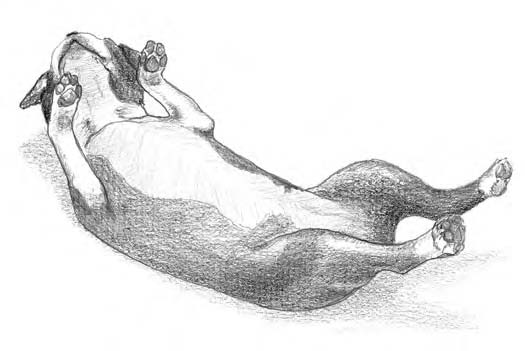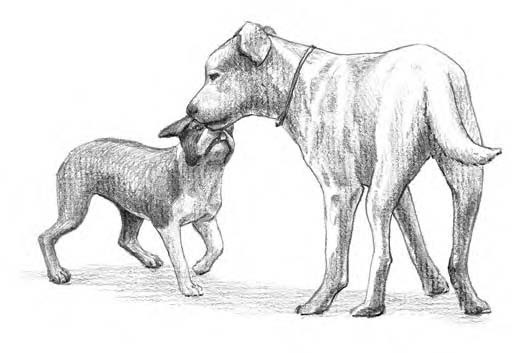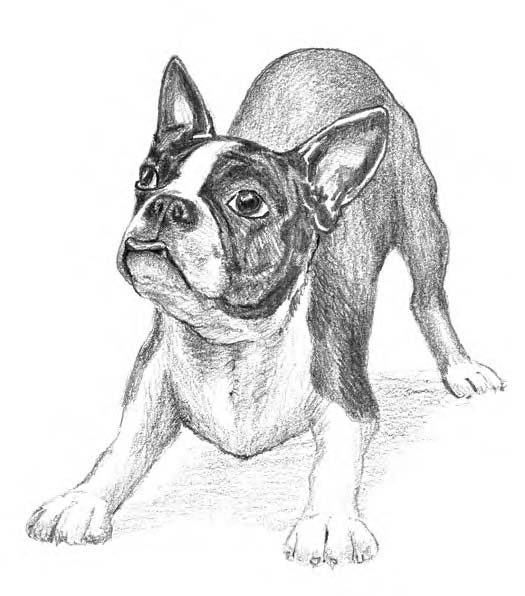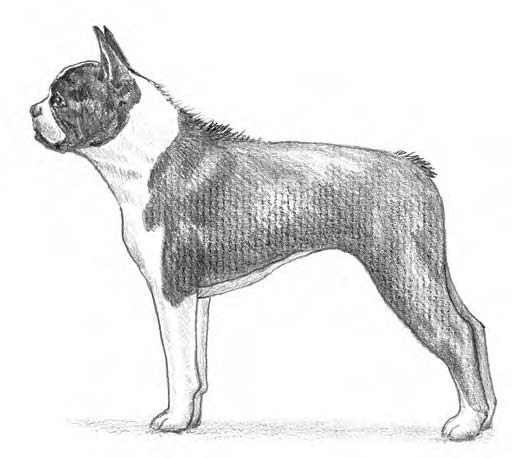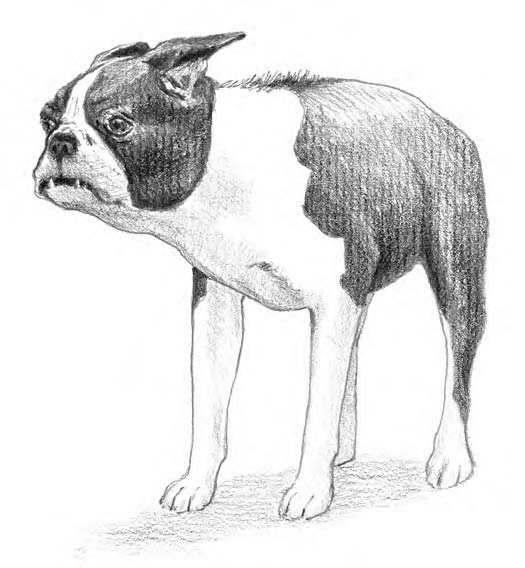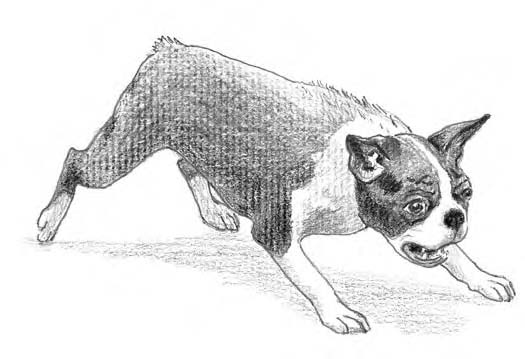- Identifying key developmental phases in your Boston’s life
- Looking at strategies for socializing your pup
- Interpreting canine body language
- Calming your dog’s fears
Awell-socialized Boston delights all who cross her path. She plays well with other dogs. She welcomes new faces, smells, sights, and sounds instead of cowering in fear. She enjoys meeting people and exploring unknown territory. In essence, she fits well in any social situation.
Understanding Your Boston’s Developmental Timeline
Warning!
If you adopt a puppy from a disreputable pet store or backyard breeder, or if you adopt an adult from a rescue organization or shelter, your Boston may have missed some of these developmental milestones. Healthy development requires human and canine contact, and some of these puppies may not have received what they required to socialize properly. They’re not hopeless cases, but these puppies require extra-special care and nurturing.
A brand-new world: The first 6 weeks
Getting to know people: 5 to 12 weeks
Warning!
Puppies experience their first fear phase when they’re around 8 weeks old. At this age, she has become very aware of the world around her, and sometimes it can be very scary. If she’s frightened by something at this age, it’s likely that she won’t get over it. Breeders know this, and they typically won’t adopt out a pup who has yet to experience this fear phase.
Remember
Though your puppy has already endured her first fear phase, ask your friends not to move too quickly or wear distracting items, like a big floppy hat or dark sunglasses, when they come to visit. Quick movements or colorful disguises can frighten a young Boston!
Interacting with her environment: 12 to 20 weeks
Tip
Puppy kindergarten offers an excellent opportunity to get your pup out of the house and into new environments. Often held at training centers, pet stores, and dog parks, puppy kindergarten introduces a dog to a new place, new people, and new dogs — a perfect social situation for a developing dog! See Chapter Training and Behavior for more information about the benefits of puppy kindergarten.
Warning!
Fourteen weeks marks an important milestone in a pup’s development: If she is kenneled and not handled before this period, she will develop some serious social problems, often acting out toward things she doesn’t understand. It’s absolutely critical that the dog is handled as much as possible during these first few months.
Approaching adulthood: 4 months to 3 years
– Another fear period: As with the fear periods at 8 and 16 weeks old, some dogs may go through another one at 14 months old that’s not as critical as the first two. During this fear period, you may notice your pup being apprehensive toward things she already knows. Help her through this by encouraging her and reassuring her, revisiting some training techniques, if necessary.
– Sexual maturity: This inevitable teenage experience occurs in both male and female dogs between 6 months and 1 year of age. Female dogs should be spayed before their first heat cycle, reducing their chances of developing reproductive system cancers and unwanted pregnancies. Male dogs should also be neutered around this same time. Doing so reduces unwanted behaviors such as aggression, urine marking, mounting, and wandering in search of a mate. (Chapter Your Visit to the Veterinarian has more specifics on spaying and neutering your Boston.)
– Social maturity: From 1 year to 3 years old, a dog continues to mature socially. She’s still considered a puppy during this time, despite her adult appearance! She continues to develop her personality, she refines her behavior, and she experiences more new sights, sounds, people, and places as her world continues to expand.
Remember
Though the dog has passed her prime for growing accustomed to various environmental stimuli, you should still expose your Boston to as many social situations as possible. By the time she reaches her third birthday, she’s ready for just about anything.
Socializing Your Puppy
Keeping her safe, yet social
Trainers recommend that your pup meet and be handled by at least 100 people of all different ages, sizes, and ethnicities during the first few months of life! She should meet people who wear glasses or hats. She should also be exposed to people who use a wheelchair or cane. She should meet the children down the street, the teenagers next door, and the retired seniors across the way. The more variety she experiences, the better.
Tip
Here are some ways to both keep her safe and allow her to meet a variety of people. Start slowly; stick to your house the first week or two and expand from there.
– Take her with you wherever you go. Dress her in a fancy pup-size collar with an ID tag, attach a matching leash, put her in colorful carrier, and let her shadow you as you go to the market, the coffee shop, or a friend’s house.
– Expose her to as many different people as possible. Let her meet your neighbors, the postal carrier, and the pet store cashier. Wherever you go, you and your adorable Boston will create a stir. Let people pet and fawn over your pup. The more people she meets, the better she’ll adjust.
– Invite friends and relatives to your house and ask each person to hold your pup. By meeting people on her own turf, your Boston develops confidence as well as social skills. And as each person handles your Boston, she gets used to being touched by different humans — all with different smells and appearances.
– Host play dates with other dog owners and their dogs who have already had their vaccinations. If you know that they’re up to date on their shots, you can have other dogs over to meet your puppy. Always supervise them, of course, especially if the dogs are older or larger than your pup.
– Avoid places where strange dogs have been. Let your Boston explore as much as she can, but steer clear of areas with potentially parasite-ridden animal feces, like public parks, beaches, or unfamiliar neighborhoods.
Introducing children — slowly
Remember
Before you let any child play with your Boston puppy, first determine how comfortable the child is with dogs. If he’s your child, you’ll know his comfort level. If he’s your child’s friend or a neighbor, ask his parents how much experience he has had with puppies. If they give you a green light, let them play together — always supervised, of course.
Tip
You can set up some ground rules to make playtime a positive one for everyone. Here are some suggestions:
– Sniff first, play later. Ask the child to approach the pup slowly and offer an outstretched hand for her to smell. If your Boston sniffs and wags her little tail, the child can pet and play with her.
– Move slowly. Don’t allow children to run or move erratically around the puppy. Doing so can be frightening or overwhelming, or the pup may accidentally be trampled. Instead, require deliberate, cautious movements, especially when the pup is very young.
– Use an inside voice. Don’t let kids scream or yell while playing with the puppy. Again, this can be overstimulating or scary to a young dog.
– Give the puppy some space. Though a Boston pup may look like an adorable stuffed animal, don’t let kids grab the pup and hug her. Instead, allow the child to pet the puppy while she’s on the ground, in her bed, or in an adult’s lap. Watch the dog’s body language. If she looks frightened, ask the child to back off a little.
– No wrestling! Part of that child-dog bond includes wrestling and playing with the pup. Some physical play is fine, but don’t let kids throw themselves on the puppy. Not only can that endanger the dog, but it can also endanger the child if the pup gets scared and nips at him.
– Limit face time. Don’t allow kids to grab your Boston’s face, put their face to hers, blow in her face, or stare at her. Those are all intimidating postures that can lead to nipping and biting later on. Let the kids pet the pup’s head, neck, back, and belly, but keep her face off-limits.
Remember
After the puppy has grown, you can relax some of these house rules. You’ll know instinctively when it’s okay for your child to play more exuberantly with your Boston. Use common sense and good judgment, always supervising the new best friends. parental supervision and ground rules, the experience can be a negative one for both the dog and the child.
Remember
Before you let any child play with your Boston puppy, first determine how comfortable the child is with dogs. If he’s your child, you’ll know his comfort level. If he’s your child’s friend or a neighbor, ask his parents how much experience he has had with puppies. If they give you a green light, let them play together — always supervised, of course.
Tip
You can set up some ground rules to make playtime a positive one for everyone. Here are some suggestions:
– Sniff first, play later. Ask the child to approach the pup slowly and offer an outstretched hand for her to smell. If your Boston sniffs and wags her little tail, the child can pet and play with her.
– Move slowly. Don’t allow children to run or move erratically around the puppy. Doing so can be frightening or overwhelming, or the pup may accidentally be trampled. Instead, require deliberate, cautious movements, especially when the pup is very young.
– Use an inside voice. Don’t let kids scream or yell while playing with the puppy. Again, this can be overstimulating or scary to a young dog.
– Give the puppy some space. Though a Boston pup may look like an adorable stuffed animal, don’t let kids grab the pup and hug her. Instead, allow the child to pet the puppy while she’s on the ground, in her bed, or in an adult’s lap. Watch the dog’s body language. If she looks frightened, ask the child to back off a little.
– No wrestling! Part of that child-dog bond includes wrestling and playing with the pup. Some physical play is fine, but don’t let kids throw themselves on the puppy. Not only can that endanger the dog, but it can also endanger the child if the pup gets scared and nips at him.
– Limit face time. Don’t allow kids to grab your Boston’s face, put their face to hers, blow in her face, or stare at her. Those are all intimidating postures that can lead to nipping and biting later on. Let the kids pet the pup’s head, neck, back, and belly, but keep her face off-limits.
Remember
After the puppy has grown, you can relax some of these house rules. You’ll know instinctively when it’s okay for your child to play more exuberantly with your Boston. Use common sense and good judgment, always supervising the new best friends.
Interacting with four-legged friends
At home
– Talk to your veterinarian. Because your vet likely cares for the other critters in your menagerie, ask him if there are any dangers to watch for, especially when your puppy is young. A grumpy 12-year-old cat may bear his claws and take a swipe at the new pup. Reptile feces can contain salmonella. Give your vet a call, just to be safe.
– Introduce them slowly. For most animals, you can create a safe environment in your kitchen or living room. Place your Boston in her carrier or kennel and allow the other animal to sniff and inspect the new puppy. After the two learn to recognize each other, give them more freedom. But don’t rush the introductions. You’ll have plenty of time!
– Always supervise. Keep an eye on your pets, especially in the beginning when they’re getting to know each other. Cats may be territorial, while other dogs may play too rough.
– Guard smaller pets. Keep pets such as reptiles and small mammals caged or in your care. Those little critters may look like prey to your puppy! Rather than risk losing a hamster or gecko, keep them locked up and safe, just in case.
Out and about
– Verify vaccinations. If you meet a fellow dog owner walking his dog, for example, ask whether the other dog is up to date on his vaccinations. Most responsible dog owners will be current with their pup’s inoculations, and they won’t be offended if you ask.
– Encourage encounters with friendly dogs. When a familiar dog approaches your Boston and you know that he is current on his shots, let them sniff each other and get to know one another. Dog parks, puppy kindergarten and other organized socialization classes, and planned play dates are great opportunities for dog-dog bonding and socializing.
– Be wary of unknown dogs. They may harbor disease or be aggressive, so steer clear of strange animals, especially those that aren’t leashed. If you see one in the distance, turn around and walk away.
– Stay away from animal feces. Parasites and diseases hide in animal excrement (see Chapter Your Visit to the Veterinarian for details), so keep your Boston far from dog, cat, and other animal feces. She’ll likely want to investigate little piles left behind, but pull her away and redirect her.
– Get involved in dog social activities. Puppy kindergarten offers a safe place for your Boston to meet other dogs and interact with other humans. Dog owners must show proof of their dog’s vaccinations before they can register, so you can be assured that your pup won’t be exposed to any disease. And you’ll meet other dog owners with pups the same age as yours, so you can talk about your pup-raising experiences — the good and bad!
Socializing Your Adult Dog
If you raise your Boston from puppyhood and socialize her properly, she already knows how to act around other animals, dogs, and humans, and she’s been exposed to a variety of environmental situations. Essentially, her brain has been programmed for how to properly behave in many different scenarios.
– Enroll in a dog obedience class. Besides learning how to obey your commands, your Boston will meet many different people and dogs, and be exposed to a new environment. By introducing her to so many new things at once, you’ll kickstart her socialization process.
– Progress to agility or other competitive sport. As soon as your dog learns some basic obedience and social skills, try her paw (or your hand) at agility or tracking (jump to Chapter Taking Training to the Next Level to learn more about these sports). These are challenging and energy-expending competitions that give your dog the opportunity to interact with many different people, dogs, and situations.
– Introduce her to new environments. As you would with a puppy, take your adult Boston with you wherever you go. Let her meet your friends and neighbors. Ask your child to invite his friends over to meet your dog. Go to a dog park. Do everything you can to expose your Boston to as many situations as possible.
– Reward her for a job well done. Positive reinforcement, or rewarding your dog for good behavior, teaches your Boston that she’ll be praised when she greets new people with a lick and a wag, or meets new dogs with a friendly sniff and play bow (see more about this posture in the “Reading Your Boston’s Body Language” section).
– Keep working at it. Dogs who have not been socialized as puppies require continuous training about how to behave among other dogs and humans. Luckily, Bostons are intelligent, and a little reminding goes a long way.
Reading Your Boston’s Body Language
Dogs don’t use words to communicate with humans, but they do use postures and body language to convey their mood. Canine body postures refer to the way a dog positions her body when she comes into contact with another dog or animal (including humans). It signals to the other animal whether she is fearful, playful, submissive, or aggressive.
Neutral relaxed
Greeting
Play bow
Tip
If you want to play with your Boston, you can strike the same pose. Lift your hands high, and then bring them down in front of you, mimicking her bowing motion. Use an upbeat, positive voice, and get ready to toss the ball!
Arousal
If she’s responding to something pleasurable, however, like when her best dog friend comes to the door, she wags her tail loosely and relaxes her muzzle, and her hackles are down. She knows something fun is about to happen, and she’s ready for it.
Defensive aggression
Aggressive attack
Submission
– Active submission: The dog tilts her head down, lowers her tail, cocks her ears back, and half-closes her eyes. She may raise her paw, and her mouth may be partly closed with her tongue tip darting in and out.
– Passive submission: The dog lies on her back, exposing her belly. She’s essentially surrendering to the other animal. She cocks her ears back, turns her head away, and tucks her tail. This is the position your pup should take when you tell her to settle. (See Chapter Training and Behavior for more about training your pup.)
Preventing Fear
Being proactive
Coping with fear
Tip
When you think your puppy is in a fear phase, you can do several things to handle her fear:
– Watch your tone of voice. When your Boston seems fearful of something, speak to her in a calm, matter-of-fact tone, or speak to her in a higher-pitched, fun tone. Tell her that it’s okay, that there’s nothing to fear. Resist the urge to use a soothing tone that she could mistake as sympathy. That only reinforces her fears.
– Distract her. Another approach is to distract your Boston by turning her away from what scared her. When you redirect her attention, give her a treat or a toy, saying, “What’s this? Here’s your ball!” The key is to make her think about something else.
– Investigate the fearful item. If the scary item is accessible, walk up to, touch it, and show her that it’s not as frightening as she thought. Approach the item and hold it, pat it, and tell her, “Look! It’s not scary.” If a cookie sheet falls to the floor, for example, walk up to it, pick it up, investigate it, and show it to your Boston. When she starts to approach and sniff it, praise her and tell her how brave she is.
– Don’t force her. Sometimes your Boston may just want to hang back and look at the scary item. That’s okay. When she’s ready, then let her approach it on her own. If you force her, you may just make the fear that much worse.
Warning!
If your pup still is afraid or starts to show signs of aggression at things she fears, you may want to talk to your vet or enlist the help of a trainer who can help you through the phase.
by Wendy Bedwell-Wilson




